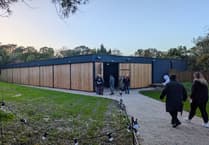EACH week, hundreds of planning applications come before Cornwall Council’s planning department, seeking to win approval for various plans right across the Duchy.
These plans can comprise of a number of different reasonings– ranging from permission to replace windows or listed building consent ranging up to large house building developments or changing of use of a building, for instance, from an office to a café, or flats.
Within this large and often complex system, there are a number of formats from which planning advice and approval can be sought.
These range from full applications where all the details which comprise a proposed development or work to a building are submitted, to outline applications, where further details are yet to be confirmed, for example, an outline application with reserved matters for appearance may not confirm the final proposed development but rather seek permission in principle.
An example of this is one for an outline permission for 20 dwellings on land with reserved matters for appearance and scale; the reserved matters would require further permission later for their inclusion.
Other types of applications include pre-application advice requests, where would-be developers submit often outline proposals to a local authority to ascertain whether it is likely to gain support or not prior to submitting a planning application.
The vast majority of applications are decided by planning officers employed by a local authority under ‘delegated powers’, meaning they do so on behalf of their employer, however, some applications are ‘called in’ by local councillors to be discussed at an area’s strategic planning committee meeting, meaning the final decision rests with a committee of councillors.
Graveyard extension granted
PROPOSALS for an extension of a graveyard at a church in Blisland has been approved by Cornwall Council.
The Blisland with Temple Parochial Church Council applied to the local authority seeking permission to convert a plot of agricultural land measuring 578 square metres into an extension to its cemetery at the St Protus and St Hyacinth church in Blisland.
The applicant told Cornwall Council: “The Site is a verdant plot of 578 square metres in area that was originally mowed lawn but has now, through neglect, become largely overgrown with nettles.
“As the Site is currently deemed to be agricultural land the PCC believes that all of the work needed to make the plot suitable for use as a graveyard – removal of weeds and self-seeded shrubbery, re-seeding as necessary, minor repairs to walls and fences – could be carried out without the need for planning permission.
“However, in order to preserve its limited funds, the PCC would prefer to defer the expense of carrying out the tidying up operation until such time as change of use permission for the Site to be used as a graveyard has been obtained.”
Cornwall Council granted permission for the works to be undertaken.
Developer bids to not build footpath
A HOUSING developer in Liskeard has submitted a request to Cornwall Council to be relieved of its Section 106 requirement for the construction of a footpath and cycle link connection at Trevethan Meadows.
Section 106, also known as planning obligations, are legal agreements between a local planning authority and a developer, binding the land and its future owners to mitigate the impact of a development on the local community and infrastructure. These agreements ensure that developers contribute to the provision of infrastructure, services, or other measures needed to make a development acceptable in planning terms.
Persimmon Homes have said that the land which the footpath and cycle link connection goes through is no longer in its ownership and is seeking advice from Cornwall Council on the mechanism which to be relieved of its obligation to provide it.
In the submission, it was stated: “Advice is sought with regard to reviewing the S106 agreement to agree a mechanism to release Persimmon Homes from the s106 obligation to provide a footpath/cycle link connection at Trevethan Meadows, Liskeard. Persimmon Homes do not own the (0.1 hec) land subject to this application, with Wain Homes currently having control and an interest over the land.
“Persimmon Homes consider a Deed of Variation/Modification is required to address a s106 obligation that we cannot deliver due to Persimmon not having any control or ownership over the subject land. A legal opinion is required to understand the councils view of this change and a confirmation of the mechanism to make said amendment.”
Accompanying documents later added: “Pre application submission advice is sought with regard to reviewing the Section 106 Agreement to agree a mechanism to release Persimmon Homes from the s106 obligation to provide a footpath/cycle link connection at Trevethan Meadows, Liskeard.
“As part of the Section 106 Agreement in connection with the original planning consent PA10/013248, Persimmon were required to provide a footpath/cycle link shown between points X and Y on drawing number 813-03. This land is no longer under the ownership or control of Persimmon Homes but owned by Wain Homes.”
Conversion of nursery into dwelling approved
THE conversion of a Grade II building from a nursery into two dwellings has been approve by Cornwall Council.
The proposals concern 20 Dean Street, Liskeard.
The applicant told Cornwall Council: “The nursery who rented 20 Dean Street have moved to new premises within Liskeard. There are currently 5 childrens nurseries and preschools within Lisekard and despite advertising for a number of months there was no demand from interested parties. Unfortunately, the nature of these 150 year old buildings does not lend itself easily to modern standards of nursery facilities and with the changes following covid to work from home it does not appeal to many businesses as offices.
“Many nursery facilities are moving to purpose built facilities to provide the most appropriate environment for their clients and to enable high standards now expected by Ofsted for early year settings. The building owner would therefore like to change the use of the building to 2 houses. National and local Planning policy supports the need for more houses and its location within the town and providing ample parking demonstrates the sustainable location. If the building was not listed a conversion to 2 houses would be permitted under permitted development rights – Class MA.
“The proposal itself is based on splitting the building in the least harmful way to maximise and retain the retained period features. The works to the building would be minimal in terms of splitting the building. It is fundamental to conservation that work which has to be done is undertaken with minimal intervention to the fabric of the building and site.
“Works of maintenance or refurbishment will not encroach on the original fabric more than is necessary to secure the future of the building. The proposed alterations, interventions and loss of historic fabric has been kept to the minimum required to facilitate the work. We believe the proposed scheme respects and retains as much historic fabric as possible and will not affect in any way the significance of the building.
The plans were approved.
Keep up to date with the latest planning applications and other statutory notices (such as alcohol licensing and probates) that affect where you live by visiting our online Public Notice Portal – be the first to know by visiting www.publicnoticeportal.uk/cornish-times-series.
.png?width=752&height=500&crop=752:500)



Comments
This article has no comments yet. Be the first to leave a comment.